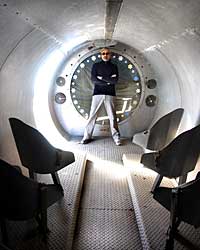The famed Astroland Rocket Ship on Coney Island's Boardwalk (historical photos available on Flickr), one of the first and only surviving early amusement park "simulators," is seeking a new home. It debuted in 1962 at Astroland Park as one of the first of the "imaginary" space voyage simulators constructed during the Space Race. The Rocket showed simulator films of "rocket rides" while the chassis "rocked" its viewers to outer space.
The Ride, which has 26 seats, lasted about three minutes, the length of the film. Originally built as the "Star Flyer," the Astroland Rocket, which is in excellent condition, currently sits atop the boardwalk hamburger/hotdog stand, Gregory and Paul's and is one of the first early victims of Coney Island's redevelopment. While the City and Thor Equities continue to negotiate over ownership of Coney Island, Astroland Park must move off the property and either sell or take everything with it. Owners Carol and Jerry Albert have offered to donate the rocket and help with the costs of moving it, "but," said owner Carol Albert, "we can't find a way to store it, inside or outside, and there seems to be no place in Coney Island where it can find a home." Astroland must vacate the property by January 31st.

Charles Denson, Executive Director of the Coney Island History Project inside the Astroland Rocket
The Alberts had long planned to preserve the park's fabulous space ship by donating it to the Coney Island History Project, the not-for-profit organization they founded in 2004.
Charles Denson, executive director of the Coney Island History Project and custodian of the Astroland rocket, would like to keep it, but the History Project's exhibition center under the Cyclone roller coaster does not have parking space for a rocket!
"The Astroland Rocket is an iconic piece of Coney Island's history that must be preserved, preferably at a site in Coney Island," says Denson, a Coney Island native and author of Coney Island Lost and Found. "The rocket was the first ride at Astroland and it defined the park's space age theme when it opened in 1962. It should remain a part of Coney's landmarked architectural heritage like the Parachute Jump, Wonder Wheel, and Cyclone roller coaster. Every effort is being made to find it a safe new home in Coney Island."
Coney Island History Project and Astroland staffers have been contacting museums and other venues offering to donate the rocket. A few museums have declined due to lack of space or logistics while others are considering the offer. "Astroland's Rocket incorporates fun, science and a piece of Coney Island history which both youngsters and adults would find unique and intriguing. In addition, the Rocket would enable a museum's educational staff to create new and exciting programming for visitors" says Astroland's Lois Colin, who has contacted children's museums, science centers, aviation museums and other venues.
If you know of a good home for the Astroland Rocket, please contact Lois Colin at lscastroland@aol.com or 718 265 2100 ext. 13 or Charles Denson at the Coney Island History Project at info@coneyislandhistory.org
Historical facts about the Rocket gathered by the Coney Island History Project:
The Astroland Rocket was also known as the "Star Flyer" (as it was called by its inventors), the "Cape Canaveral Satellite Jet" (Time Magazine), "The Spaceship Auditorium" (Billboard) and the "Cannonball Adderly Rocket" in anticipation of Adderly dedicating the rocket for the park's official opening on July 1, 1962. The rocket was rechristened the "Astroland Moon Rocket" in 1963.
A Time Magazine article from July 1963 describes Coney Island's new park as "a $3,000,000 fun-and-games nexus devoted to space exploration. It has the Cape Canaveral Satellite Jet - passengers enter the rocket, fasten seat belts, then blast off with engines roaring as filmed special-effects from actual space shots conjure up a journey to the moon. The Colonel Glenn Sky Ride has 16 plastic bubbles orbiting 80 feet above the boardwalk. For downward exploration the Neptune Diving Bell encloses 30 people, drops them 35 feet down to an 'ocean floor' where live porpoises play."
http://www.time.com/time/magazine/article/0,9171,875038,00.html?iid=chix-sphere
A view of the rocket and other space themed rides at Astroland can be seen in this photo exhibition from the Astroland archives at the Coney Island History Project in the summer 2008: http://www.flickr.com/photos/27583836@N08/sets/72157606405192610/
The rocket continued to operate as a ride through the 1970s. According to the text of the History Project's Astroland exhibit curated by historian Charles Denson: "In late 1961 Dewey Albert and his son Jerry Albert began transforming the Feltmans property into a space age theme park they called Feltmans Astro Park. By the time it opened to the public in the summer of 1962 it had become 'Astroland Park.' After the closure of Steeplechase Park in 1964, the Albert family's Astroland provided the anchor that held Coney Island together during the next four turbulent decades."
According to "Space Age Lure," an article in Billboard's 1960 Cavalcade of Fairs, the Star Flyer rocket ride was invented by John Taggart and Sam Daugherty, former police officers turned space age amusement entrepreneurs. In 1958, the year Explorer 1, the first U.S. satellite, lifted off at Cape Canaveral and N.A.S.A. was founded, Taggart and Daugherty formed the U.S. Amusement Corporation. The rockets were built at Todd Shipyards in California. The prototype was installed at Peralta Park in Oakland in June 1958. Star Flyer II was a sensation at the 1959 State Fair of Texas in Dallas, riding approx 40,000 children and adults during the 17 day fair. By 1960 three rockets had been built: one was traveling with Royal American Shows, the largest carnival of its day, and the other two were in Palisades Park and Riverside Park. Dewey and Jerry Albert, who had rides at Palisades Park, first saw the rocket there and were inspired to buy one for their new space-age theme park.

Add new comment